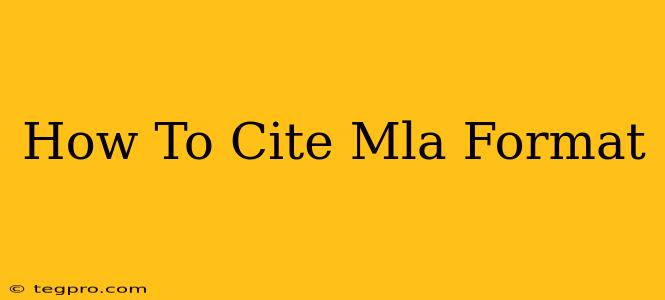Proper citation is crucial for academic integrity. Understanding how to cite sources in MLA format is essential for students and researchers alike. This guide provides a comprehensive overview of MLA 8th edition citation, covering everything from in-text citations to the Works Cited page. We'll break down the process step-by-step, making it easy to avoid plagiarism and demonstrate your research skills effectively.
Understanding MLA Format: The Basics
The Modern Language Association (MLA) style is widely used in the humanities, particularly in literature, languages, and cultural studies. Its core principles emphasize clear, concise referencing to give credit to original authors and avoid academic dishonesty. The key components of MLA citation are:
- In-text citations: Brief references within your text that indicate the source of your information.
- Works Cited page: A separate page at the end of your paper listing all the sources you cited in alphabetical order.
In-Text Citations: Giving Credit Where It's Due
In-text citations are the cornerstone of MLA style. They provide your reader with immediate context, allowing them to easily locate the full citation in your Works Cited page. The basic format typically includes the author's last name and the page number (if applicable).
Examples of In-Text Citations:
- One author: (Smith 12).
- Two authors: (Smith and Jones 12).
- Three or more authors: (Smith et al. 12).
- No author: ("Title of Work" 12). Use a shortened version of the title if it's long.
- Indirect source: (Smith, qtd. in Jones 12). Use "qtd. in" to indicate a quote within another source.
- Website with no page numbers: (Smith, para. 2). Use paragraph number instead.
Important Considerations for In-Text Citations:
- Placement: Place in-text citations at the end of the sentence containing the borrowed information, before the period.
- Multiple citations: If you cite multiple sources in one sentence, list them in alphabetical order, separating them with semicolons. (Smith 12; Jones 15).
- Consistency: Maintain consistency throughout your paper.
Creating Your Works Cited Page: The Complete List
The Works Cited page is an alphabetical list of all the sources cited in your paper. Each entry follows a specific format, depending on the source type (book, article, website, etc.). Here's a breakdown of some common source types:
Works Cited Examples:
Book:
- Author's Last Name, Author's First Name. Title of Book. Publisher, Publication Year.
Example:
- Smith, John. A Guide to MLA Citation. Oxford University Press, 2023.
Journal Article:
- Author's Last Name, Author's First Name. "Title of Article." Title of Journal, vol. volume number, no. issue number, year, pages. Database Name, DOI or URL.
Example:
- Jones, Jane. "The Impact of Technology on Education." Journal of Educational Technology, vol. 10, no. 2, 2023, pp. 55-70. JSTOR, doi:10.1234/jet.12345
Website:
- Author's Last Name, Author's First Name (if available). "Title of Page." Title of Website, Publisher (if available), Date of Publication or Last Update (if available), URL.
Example:
- MLA International Bibliography. "MLA Handbook." Modern Language Association, Modern Language Association, 2023, https://www.mla.org/MLA-Handbook (replace with actual URL).
Note: These are simplified examples. The actual format may vary depending on specific details of the source. Consult the official MLA Handbook for the most up-to-date and detailed guidance.
Mastering MLA Citation: Tips for Success
- Start early: Don't wait until the last minute to cite your sources.
- Keep track: Use a citation manager or a consistent note-taking system to track your sources.
- Double-check: Always proofread your citations carefully for accuracy.
- Consult the handbook: The official MLA Handbook is the ultimate authority on MLA style.
- Seek assistance: If you are struggling, seek help from your instructor or a librarian.
By following these guidelines, you can effectively and accurately cite your sources in MLA format, ensuring academic honesty and presenting your research with professionalism. Remember, proper citation is not just a formality; it's a fundamental aspect of academic integrity and responsible scholarship.

